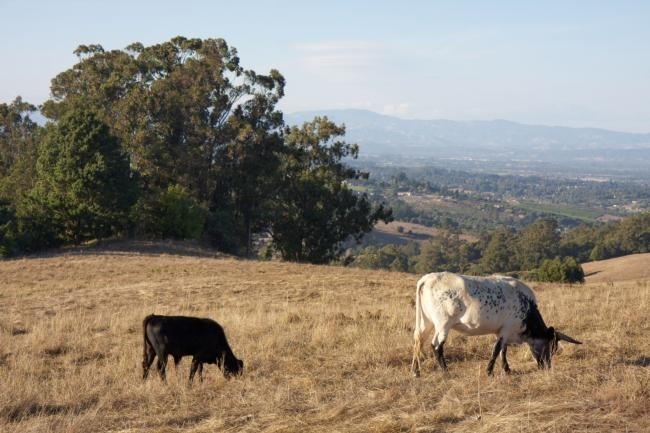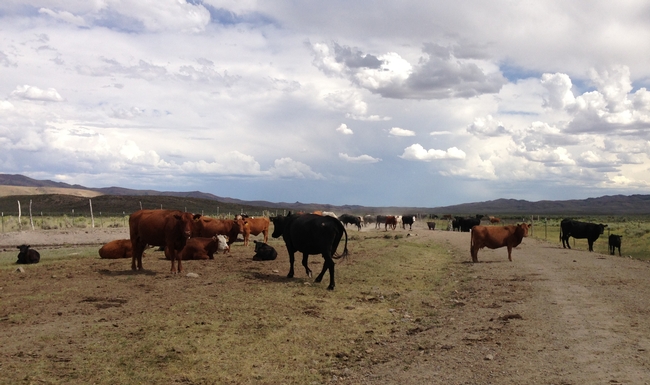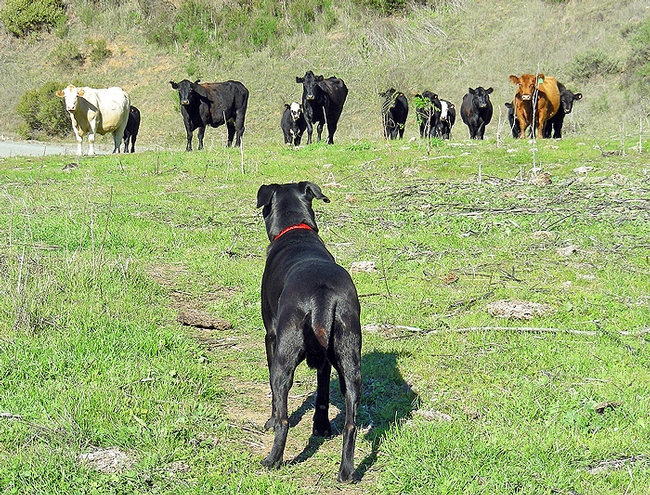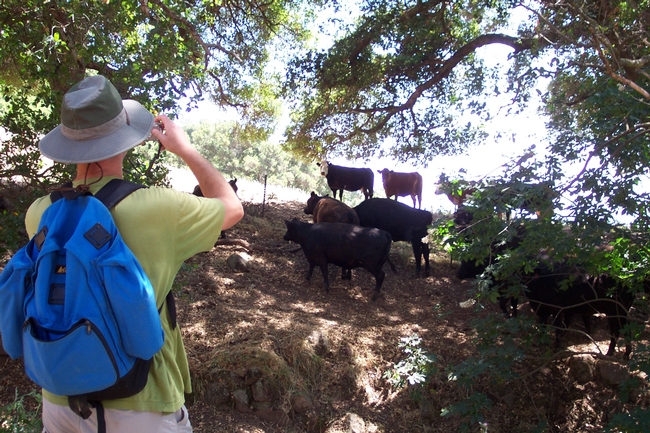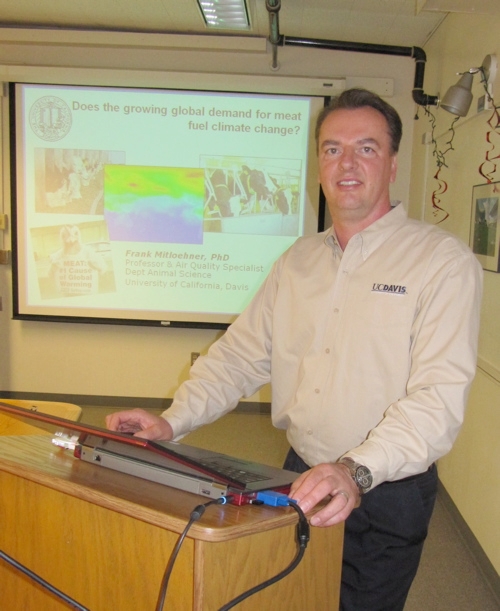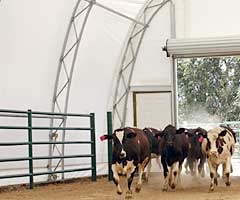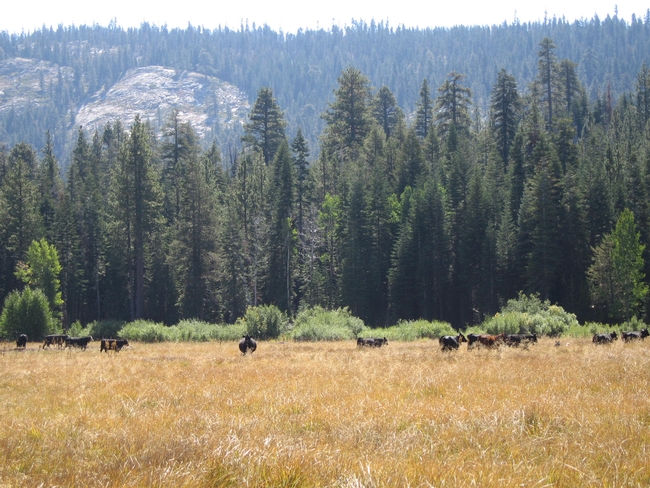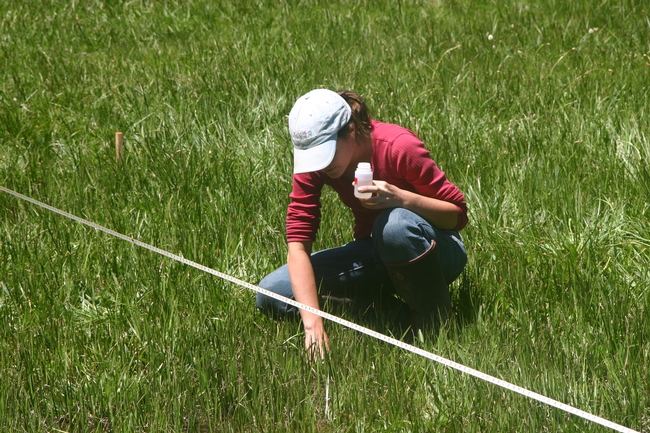Posts Tagged: cattle
Central Coast cattle industry suffering losses due to drought
Since the late 1700s, grazing has been the best use for the rolling hills and valleys of California's Central Coast, reported Louis Sahagun in the Los Angeles Times. However, because of the state's four-year drought, three-quarters of the cattle in San Luis Obispo County have been sold or taken out of state. The sell-off brought in a record $129 million last year.
"We see clearly what a bust cycle looks like," said Mark Battany, UC Agriculture and Natural Resources viticulture and soils advisor in SLO County. "Ranchers have no choice but to sell off their cows and rebuild the herd when the rain comes back."
Sahagun reported that ranchers in the area have suffered severe drought for centuries.
"During a drought that ended in 1864, some ranchers drove their herds off cliffs and into the ocean below to stop their suffering," the article said.
The current drought is leaving landowners few options. The county placed a two-year moratorium on new agriculture that depending on the aquifer, so rangeland can't be converted to vineyards at the moment.
"Ranchers are getting hit hard from every direction," said Royce Larsen, UC ANR natural resource watershed advisor in SLO County. "It's a grim and desperate outlook."
Other news over the weekend included:
Holy S***! Almonds require a ton of bees
Tom Philpott, Mother Jones, May 25, 2015
Growing almonds in California takes about 1.7 million bee hives, drawing a large fraction of the nation's available bee hives. Why don't they stay in California? The state is already home to 500,000 of the nation's 2.7 million hives, said Eric Mussen, UC ANR specialist emeritus based at UC Davis. The almond bloom is great for a few weeks, but in terms of year-round foraging, "California is already at or near its carrying capacity for honeybees," he said.
Farm Beat: Here is how hikers, cattle can coexist
John Holland, Modesto Bee, May 22, 2015
UC ANR released a five-page brochure last month that shows how hikers and other visitors can avoid conflicts with cattle that graze on public land. Cattle fatten up nicely when they can graze calmly – good for the rancher and good for the buyer of the meat down the line, the story said.
Tips for cattle health and safety during dry times
Long before Governor Brown declared an official drought for the state, many of California's ranchers knew this would be a tough year. Drought can increase the risks of animal poisonings and nutritional imbalances, and necessitate additional vigilance to assure cattle health and productivity. Veterinary toxicologists Robert H. Poppenga and Birgit Puschner, with the California Animal Health and Food Safety Laboratory System at UC Davis School of Veterinary Medicine, provide this critical information to dairy and beef producers to keep their livestock healthy during the drought. Key threats to cattle include:
Water quality — Water is the most critical factor in the diet of food animals. When cattle don't drink enough clean and safe water every day, feed intake and productivity declines. Drought conditions can potentially affect all sources of water, including groundwater, but surface waters are especially vulnerable. It is important to frequently monitor water quality, especially as quantity becomes more limited, and test for basic water quality parameters such as total dissolved solids, sodium, sulfates, and nitrates/nitrites. Blooms of blue-green algae in water are also an issue. These cyanobacteria can produce toxins that can affect the liver and nervous system. Depending on the specific toxin and amount ingested, animals may die suddenly, or suffer from weakness, staggering, or photosensitization.
Feed quality and nutritional deficiencies — Drought conditions frequently result in the need to feed poor quality forages or to switch to alternative feed sources. Both can affect animal nutrition and increase the risk for intoxications. Use of poor quality forages can cause or exacerbate deficiencies of important minerals such as selenium, copper, and phosphorus and vitamins such as vitamins A and E. In addition, drought affected forages are often deficient in energy and protein. Even in non-drought years, deficiencies in selenium and copper are common in California cattle, particularly beef cattle. Copper deficiency causes reduced production, diarrhea, decreased resistance to infectious agents and parasites, poor vaccine response, loss of bone strength in calves, weakness and wobbling in neonates, reproductive failure, and sudden death of adult animals. Selenium deficiency also results in less resistance to infectious agents and parasites, and causes white muscle disease of skeletal and heart muscle resulting in stiff gaits, slow movement, heart damage and weak neonates. Primary vitamin A deficiency occurs in beef cattle on dry range pasture during periods of drought. Clinical signs include night blindness, dry eye, retarded growth rate, reproductive failures, and increased mortality. Maternal deficiency of vitamin A can cause abortions, stillbirths, or calves born alive but blind and weak that die within 1 to 3 days. Cows should be given an injection of vitamin A (and D) about 30 days prior to calving and calves should be given a vitamin A injection at birth.
Increased incidence of plant poisonings — Cattle will seek out and consume plants that they would not otherwise find palatable during drought conditions. Nitrate poisoning is one of the most common plant associated intoxications diagnosed by the California Animal Health and Food Safety Laboratory. The potential for nitrate poisoning to occur is increased when livestock water sources also contain elevated concentrations. The first sign of nitrate poisoning is often the sudden and unexplained deaths of one or more animals. Other clinical signs include drowsiness, weakness, muscle tremors, increased heart and respiratory rates, staggering, and recumbency. Signs can develop with several hours of ingesting a toxic amount. Nitrate concentrations can be easily and cheaply determined from samples submitted to a veterinary diagnostic laboratory for testing.
During periods of drought, cattle producers should be especially careful about the quality of feed and water available for their animals. Sick animals should be tested for various nutritional deficiencies and dead animals can undergo necropsies to determine cause of death so that other animals in the herd can be treated appropriately. Additional information and testing is available at the California Animal Health and Food Safety Laboratory System. For laboratory location and contact info, visit www.cahfs.ucdavis.edu. A longer, more detailed version of these tips may be found here.
Robert H. Poppenga and Birgit Puschner, veterinary toxicologists with the California Animal Health and Food Safety Laboratory System at UC Davis School of Veterinary Medicine, contributed to this article.
Does social media reveal how we feel about cattle grazing?
To get a more complete picture of public perceptions of cattle grazing, Sheila Barry, University of California Cooperative Extension advisor in the San Francisco Bay Area, analyzed photos and comments in the photo-sharing website Flickr.
Her study, published in the February 2014 issue of Environmental Management, showed that Flickr can provide insight both through photos and comments into public perspectives on grazing in parks and open space lands.
“These are just a first step toward broadening this understanding,” Barry wrote. “Further analysis of social media may provide managers with broader insights into public opinion compared to those afforded by traditional methods on a wide range of issues important to park and open space management.” Livestock grazing reduces the volume of plants that can fuel fire and improves wildlife habitat. But some public land managers, concerned about potential conflicts with park users, limit or ban grazing. In 2009, the city of Walnut Creek decided to end grazing in two city parks. A year later, neighbors who were concerned about weeds contributing to wildfire petitioned the city to resume cattle grazing.
Assessments of public perceptions are often based on public hearings, which tend to attract special interests and favor negative input, or on surveys, which focus on a topic.
“Despite numerous studies that have shown benefits of grazing for endangered species in California, some environmental groups and park users have filed lawsuits to curtail grazing on public rangelands,” Barry said. “I think there's an opportunity to educate people that if grazing is well managed, it won't interfere with their recreational use and there are benefits to society.”
The San Francisco Bay Area has over 133,000 acres of public land that is grazed by cattle and used by people to hike, ride bikes, walk dogs, ride horses and hang glide.
Barry set out to explore how people voluntarily described their feelings about cattle grazing in the San Francisco Bay Area on social media. She examined photos and comments on Flickr. Using the search terms “cow,” “cows” and “grazing,” she found 1,087 photos of grazed regional parks in Alameda, Contra Costa or Santa Clara counties by 328 people with 956 comments.
Of the 733 photos that were accompanied by comments, 71 percent showed a cow and 71 percent of the comments were descriptive without expressing opinion about cows or grazing. Comments included “Lots of wildflowers and cows. Hello tiny cows on the hillside.” “Taken at Lake Del Valle.” “I don't know why, but I thought cows in California were kept indoors.” About 23 percent were positive toward cows and grazing, such as “Wonderful to see cows being just cows and happy ones” and “As much as I struggled over the steep hills on this hike, all the grazing cattle and howling coyotes made it worth the sweat.”
Fear of cows was expressed by 5 percent of commenters and included comments such as “I try to conquer my fear of cows by photographing them,” “The cows scared us to death. I told them that I'm a vegetarian and they let me go” and “We turned around when we were faced with the option of having to walk right through a herd of cows.”
Less than 1 percent described cows behaving aggressively, such as “At least these cows didn't chase us like last week's did.”
Although more research is needed to learn how to collect, analyze and interpret data from social media, Barry believes it could be a valuable source for informing decisions about public policy.
Insight into public perceptions of cattle grazing will enable park managers to craft more effective education and interpretation messages about park use and management.
“We are currently using insight from this project to develop education and interpretative information and panels for parks in the East Bay,” Barry said.
Barry is publishing fact sheets for park managers and interpreters to share with park visitors. The fact sheets will address concerns she saw raised in the Flickr study such as how to safely and comfortably recreate in a park near grazing cattle and the benefits of cattle grazing in parks. She will also address public interest and questions revealed in the Flickr study with facts sheets titled “A Year in the Life” and “Bovines, Ovines, Caprines and Equines: What's the difference?” The fact sheets will also be available online and similar information will be posted in parks on interpretative panels.
The article “Using Social Media to Discover Public Values, Interests, and Perceptions about Cattle Grazing on Park Lands” can be downloaded at http://link.springer.com/article/10.1007%2Fs00267-013-0216-4.
Is livestock’s contribution to climate change still being overestimated?
In a 1,000 year old village in Germany (Juehnde), methane is not a dirty word. The recovered methane from a manure-fueled bioreactor feeds the burners that heat water for every household in the village. The same hot water provides heating. These households benefit from living adjacent to a livestock economy whose manure was once just a smelly nuisance. The manure is transported by truck to an enclosed bioreactor, thereby reducing odor and feeding a system that powers an entire community. Frank Mitloehner once called this village home. Now a professor and air quality UC Cooperative Extension specialist in the Department of Animal Science at UC Davis, Mitloehner thinks that if this village can do it, so can California.
It is easy to see how Mitloehner was inspired to study ways that California can take advantage of its plentiful supplies of animal methane. In eight bovine bio-bubbles that function as airtight barns, he captures and measures every emission from his resident livestock in order to understand how methane emissions vary with feed and herd management.
At Davis, a commercialized version of a similar methane bio-reactor has been patented and licensed by Ruihong Zhang, professor in the Department of Biological and Agricultural Engineering at UC Davis. It has been constructed at the local landfill and will be used to demonstrate a sustainable village on the UC Davis campus.
Mitloehner recently hosted a seminar for the Western Center for Agricultural Health and Safety at Davis. Since the Food and Agriculture Organization of the United Nations (FAO) committee released their 2006 report entitled, “Livestock’s Long Shadow,” he has challenged two key misleading sentences in their report. The phrase compared the contribution of livestock emissions to that of transportation. By saying the contributions to climate change were similar, the report led many environmental advocates to the conclusion that eating less meat was the equivalent of taking cars off the road, setting up a meat vs. miles tradeoff that exaggerated the methane contributions of livestock everywhere.
Mitloehner’s response was the publication Clearing the Air, Livestock’s Contribution to Climate Change. After his paper was released, BBC, CNN and other media published his science-based estimate that the livestock contribution in the U.S. is 3.4 percent of U.S. emissions. Globally, 18 percent of warming was estimated to be livestock related. This estimate included livestock in the broadest sense - changes in land use, deforestation and desertification in developing countries.
In spite of Mitloehner’s paper, the meat vs. miles perception has persisted among advocates, while press about transportation GHG has dwindled. Toyota took advantage in their advertising by showing how Prius emissions were more favorable than those of a sheep.
Nonetheless, Mitloehner showed that U.S. methane emissions remain flat, while developing countries are increasing animal production to meet the demand for eggs, meat and dairy, especially Asia. But why is the U.S. so low?
Mitloehner shared a few facts that help explain the phenomena:
- The U.S. has fewer dairy cows. Today’s 9 million dairy cows supply 60 percent more milk than the 16 million cows in production in 1950. That means there is increased efficiency per cow for the same methane produced.
- Thirty percent of the methane in dairy production is from manure in ponds. There is the potential for recovery on the approximately 1,500 California farms, where the average herd size is 1,100 head.
- Methane has 20 times the warming potential of carbon dioxide, but when burned to heat water or to generate power, its warming potential is reduced by a factor of 20.
- The more fiber in the feed, the more methane is released by the rumen of the animal. One dairy cow in the U.S. produces an average of 20,000 lbs of milk per cow annually, the same amount of milk as five cows in Mexico, or up to 100 cows in India for the same, or less methane per cow. Reasons: low fiber diet, less parasites and less disease result in large differences in production per cow.
Mitloehner occupies that middle space between the economically driven farmers who survived years of falling milk prices and the sustainable advocates that want dairy to either disappear entirely or retreat into historical practices. When he is not serving on the President’s Council of Advisors on Science and Technology (PCAST) or the National Academies Institute of Medicine, he keeps company with local farmers and students and answers to science.
Dairy addicts like myself, whose ancestors have evolved on milk for over 10,000 years, are likely to continue to frequent the organic dairy cases, hopeful that there are mutual benefits to paying higher prices for local labels in returnable glass bottles as a way to sustain the farms.
In reality, California has been exporting surplus dairy products to growing populations since the 1890s and that won’t change soon. Those markets do more to keep dairies profitable than my weekly milk and yogurt purchase. Lactose for pharmaceuticals and whey proteins for infant formulas are shipped internationally from several of California’s mammoth cheese factories, sometimes worth more the cheese itself.
Mitloehner believes that “sustainable intensification” is the solution to keeping local dairies viable. He believes that science will provide the path to better regulation. The dairy nations that seem determined to get at the truth - New Zealand, France, Ireland and the Netherlands - have formed an international partnership at FAO entitled LEAP to address the issues. Mitloehner's leadership a chair of the partnership will keep methane bioreactors on the agenda.
More information:
Mitloehner tells the story of how he neutralized errors in the FAO report “Livestock’s Long Shadow” (YOUtube).
LEAP site at the FAO. NGOs include World Wildlife Federation and Greenpeace. Mitloehner said that Greenpeace is also a partner although not listed on the site. Workshop materials available for download.
July 2012 opinion post by Robert Goodland at New York Times food blog. This is an example of criticism of Mitloehner’s role as head of the FAO partnership LEAP (Livestock Environmental Assessment and Performance).
Cattle grazing and clean water not mutually exclusive
Cattle grazing and clean water can coexist on national forest lands, according to research by the University of California, Davis.
The study, published June 27 in the journal PLOS ONE, is the most comprehensive examination of water quality on National Forest public grazing lands to date.
“There’s been a lot of concern about public lands and water quality, especially with cattle grazing,” said lead author Leslie Roche, a postdoctoral scholar in the UC Davis Department of Plant Sciences. “We’re able to show that livestock grazing, public recreation and the provisioning of clean water can be compatible goals.”
Roughly 1.8 million livestock graze on national forest lands in the western United States each year, the study said. In California, 500 active grazing allotments support 97,000 livestock across 8 million acres on 17 national forests.
“With an annual recreating population of over 26 million, California’s national forests are at the crossroad of a growing debate about the compatibility of livestock grazing with other activities dependent upon clean, safe water,” the study’s authors write.
“We often hear that livestock production isn’t compatible with environmental goals,” said principal investigator Kenneth Tate, UC Cooperative Extension specialist in the Department of Plant Sciences at UC Davis. “This helps to show that’s not absolutely true. There is no real evidence that we’re creating hot spots of human health risk with livestock grazing in these areas.”
The study was conducted in 2011, during the grazing and recreation season of June through November. Nearly 40 UC Davis researchers, ranchers, U.S. Department of Agriculture Forest Service staff and environmental stakeholders went out by foot and on horseback, hiking across meadows, along campsites, and down ravines to collect 743 water samples from 155 sites across five national forests in northern California.
These areas stretched from Klamath National Forest to Plumas, Tahoe, Stanislaus and Shasta-Trinity national forests. They included key cattle grazing areas, recreational lands and places where neither cattle nor humans tend to wander.
UC Davis researchers analyzed the water samples for microbial and nutrient pollution, including fecal indicator bacteria, fecal coliform, E. coli, nitrogen and phosphorous.
The scientists found that recreation sites were the cleanest, with the lowest levels of fecal indicator bacteria. They found no significant differences in fecal indicator bacteria between grazing lands and areas without recreation or grazing. Overall, 83 percent of all sample sites and 95 percent of all water samples collected were below U.S. Environmental Protection Agency benchmarks for human health.
The study noted that several regional regulatory programs use different water quality standards for fecal bacteria. For instance, most of the study’s sample sites would exceed levels set by a more restrictive standard based on fecal coliform concentrations. However, the U.S. EPA states that E. coli are better indicators of fecal contamination and provide the most accurate assessment of water quality conditions and human health risks.
The study also found that all nutrient concentrations were at or below background levels, and no samples exceeded concentrations of ecological or human health concern.
The study was funded by the USDA Forest Service, Region 5.
The study has been covered by Bloomberg, Cattle Network, Progressive Cattle, Science Daily and AgWeb.


